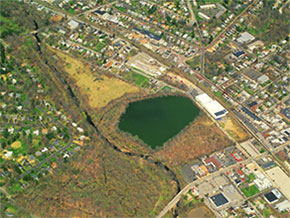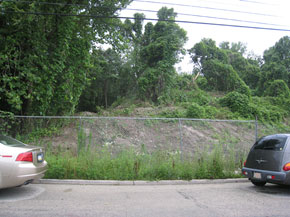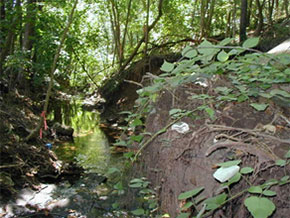Borit: Pennsylvania Department of Health (PADOH)
Borit: Pennsylvania Department of Health (PADOH) evaluated air sampling and soil data for asbestos, collected at both on-site and off-site locations. As part of the removal activities and the Remedial Investigation/Feasibility Study, EPA collected ambient air samples for asbestos, as well as activity-based sampling (ABS), to determine the potential exposure levels to asbestos in the air during vigorous activities such as lawn raking, children outdoors playing while lawn maintenance occurs, jogging, disturbing site soils and potential trespassing on the site itself. Using the air sampling data, PADOH assessed potential cancer risk for inhalation exposures to asbestos, on and off the Borit site.
PADOH also reviewed on-site soil and adjacent surface water data collected for asbestos. Lastly, PADOH compiled health outcome data, from the Pennsylvania Cancer Registry, for the Ambler community.

Aerial view of the BoRit site, showing the Park, Pond and Pile portions, and the surrounding community of Ambler. The site was historically used to dispose of asbestos-containing materials (ACM) from the nearby Keasbey & Mattison Company from the early 1900’s to the late 1960’s. The park is approximately 11 acres and was formally used as a park/playground for a number of years. The Pond is 15-acres in size and formerly had an asbestos berm constructed of asbestos shingles, millboard, and soil. The pile comprises 6 acres and was approximately 25 feet high.

Fence line view of the Pile portion of the Borit site, prior to EPA site work. EPA site work has included stabilizing and covering waste on the site to reduce the potential for airborne asbestos to migrate into the community. ATSDR and the Pennsylvania Department of Health (PADOH) evaluated asbestos air and soil sampling data collected on the Borit site and in the community.

Prior manufacturing and disposal activities left ACM along the Wissahickon Creek, on the stream banks, and along adjacent trails. The community was concerned that if pipes or tiles containing asbestos were dry and broken, asbestos could be released into the air. To address the potential for airborne asbestos, EPA removed ACM and collected activity-based air sampling for asbestos during walking, jogging and mowing activities along the trails. ATSDR and PADOH recommended residents not disturb ACM and if they did come in contact with ACM to clean shoes and wash hands outside and wash their clothes separately.